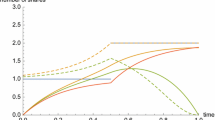Abstract
This paper empirically compares two multiperiod hedging strategies—a strip hedge and a stack-and-roll hedge—to hedge a forward commitment. The multiperiod strip hedge is found to outperform the stack-and-roll hedge when forward prices are subject to multiple sources of price uncertainty and to perform no better when only one source of uncertainty is present. Moreover, the relative superiority of the strip hedge increases with the presence of multiple sources of uncertainty. Last, the strip hedge is found to be more costly to trade than the stack-and-roll hedge; however, its cost varies directly with its superiority at reducing risk.
Similar content being viewed by others
References
Anderson, R. W. and J. P. Danthine, “The Time Pattern of Hedging and the Volatility of Futures Prices.” Review of Economic Studies 50, 49-266, (1983).
Baesel, J. and D. Grant, “Optimal Sequential Futures Trading.” Journal of Financial and Quantitative Analysis 17, 683-695, (1982).
Brennan, M. J. and N. I. Crew, “Hedging Long Maturity Commodity Commitments with Short-dated Futures Contracts,” in M. M. H. Dempster and S. R. Pliska (Eds), Mathematics of Derivative Securities. Cambridge University Press, 1997.
Chou, W. L., K. K. Fan Denis and C. F. Lee, “Hedging with the Nikkei Index Futures: The Conventional Model versus the Error Correction Model.” Quarterly Review of Economics and Finance 36, 495-505, (1996).
Duffie, D., Futures Markets, NJ: Prentice Hall, 1989.
Ederington, L. H., “The Hedging Performance of the New Futures Markets.” Journal of Finance 34, 157-170, (1979).
Engle, R. F. and C. W. J. Granger, “Co-integration and Error Correction, Estimation and Testing.” Econometrica 55, 251-276, (1987).
Ghosh, A., “Hedging with Stock Index Futures: Estimation and Forecasting with Error Correction Model.” Journal of Futures Markets 13, 743-752, (1993).
Ghosh, A., “The Hedging Effectiveness of ECU Futures Contracts: Forecasting Evidence from and Error Correction Model.” Financial Review 30, 567-581, (1995).
Gibson, R. and E. S. Schwartz, “Stochastic Convenience Yield and the Pricing of Oil Contingent Claims.” Journal of Finance 45, 959-976, (1990).
Granger, C. W. J., “Some Properties of Time Series Data and Their Use in Econometric Model Specification.” Journal of Econometrics 16, 121-130, (1981).
Grant, D., “Rolling the Hedge Forward: An Extension.” Financial Management 13, 26-28, (1984).
Hilliard, J. E., “Analytics Underlying the Metallgesellschaft Hedge: Short Term Futures in a Multi-Period Environment.” Review of Quantitative Finance and Accounting 12, 195-220, (1999).
Ho, T. S. Y., “Intertemporal Commodity Futures Hedging and the Production Decision.” Journal of Finance 39, 351-376, (1984).
Kolb, R. W., Futures, Options, and Swaps, third edition, Malden, MA: Blackwell, 2000.
Lien, D. H. D., “The Effect of the Cointegration Relationship on Futures Hedging: A Note.” Journal of Futures Markets 16, 773-780, (1996).
Lien, D. and D. R. Shaffer, “Hedging Multiperiod Forward Commitments: The Case of Period-by-Period Quantity Uncertainty.” Review of Quantitative Finance and Accounting 16, 171-181, (2001).
McCabe, G. M. and C. T. Franckle, “The Effectiveness of Rolling the Hedge Forward in the Treasury Bill Futures Market.” Financial Management 12, 21-29, (1983).
Neuberger, A., “Hedging Long Term Exposures with Multiple Short Term Futures Contracts.” Review of Financial Studies 12, 429-459, (1999).
Pirrong, S. C., “Metallgesellschaft: A Prudent Hedger Ruined, or a Wildcatter on NYMEX?” Journal of Futures Markets 17, 543-578, (1997).
Ross, S. A., “Hedging Long Run Commitments: Exercises in Incomplete Market Pricing.” Economic Notes 26, 385-419, (1997).
Schwartz, E. S., “The Stochastic Behavior of Commodity Prices: Implications for Valuation and Hedging.” Journal of Finance 52, 923-973, (1997).
Schwartz, E. S., “Valuing Long-Term Commodity Assets.” Financial Management 27, 57-66, (1998).
Author information
Authors and Affiliations
Corresponding author
Rights and permissions
About this article
Cite this article
Lien, D., Shaffer, D.R. Multiperiod Strip Hedging of Forward Commitments. Review of Quantitative Finance and Accounting 18, 345–358 (2002). https://doi.org/10.1023/A:1015401719441
Issue Date:
DOI: https://doi.org/10.1023/A:1015401719441




